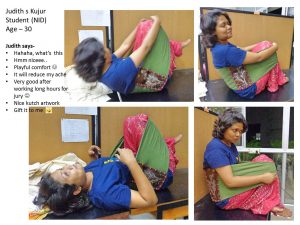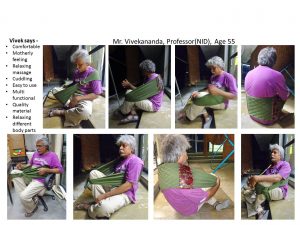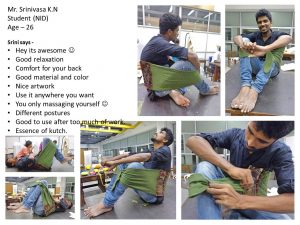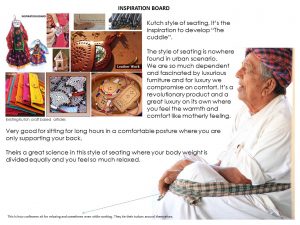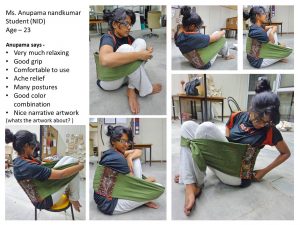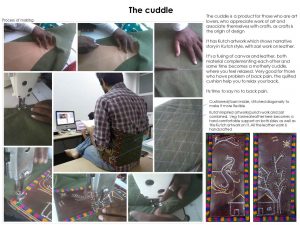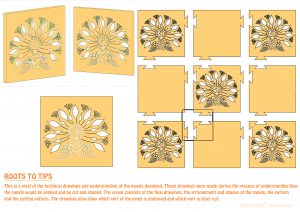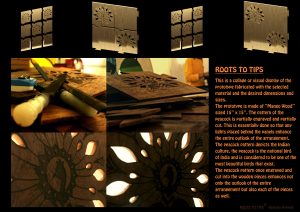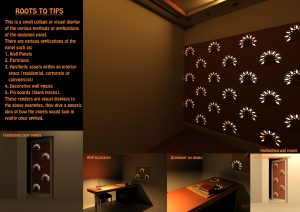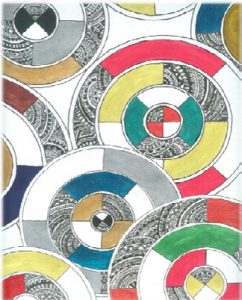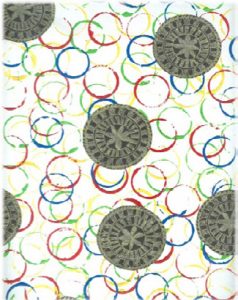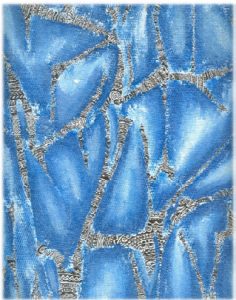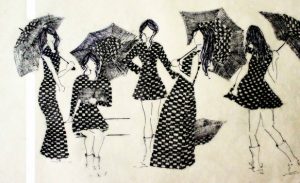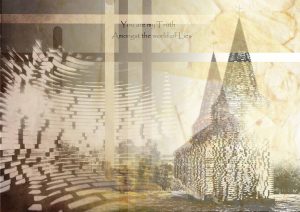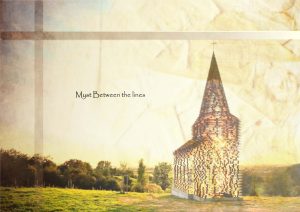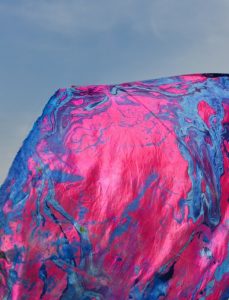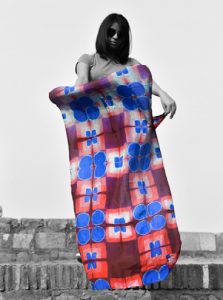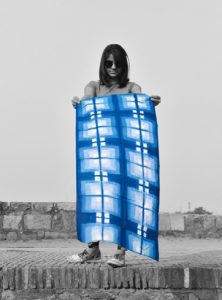MADE IN… INDIA DESIGN SCHOOLS COMPETITION: WINNING PROJECTS
Category: Furniture
Project Name: The Cuddle
Designer: Manoj Kuldeep
Born: 27 January 1986, India, Jaipur
School: National Institute Of Design, Ahmedabad
“The cuddle” is a product for those who appreciate art and associate themselves with art, as art & craft is the origin of design.
Taking inspiration from traditional kutch jari work on leather, the cuddle is designed to help the user sit comfortably and in the right posture, whilst being easy to carry. Canvas and vegetable dyed, tanned leather are fused together. Kutch style artwork creates a narrative on the leather. Biased canvas fabric is used for its flexibility.
Kutch style seating is the inspiration behind the cuddle. One would never find this in a commercial environment, where the emphasis is on luxury furnishings that often compromise on comfort. The cuddle is in fact a seating revolution, which makes it a luxury in its own right. It conveys feelings of warmth, like being in a motherly embrace. It is very good for those who need to sit for long hours in a comfortable posture with the back supported. The simple science behind this invention is that one’s body weight is balanced, which instantly makes one feel relaxed.
Category: Home Accessories
Project Name: Roots to tips
Designer: Namrata Kotwani
Born: 21 March 1995, India, Mumbai
School: Raffles Design International, Mumbai
Category: Home Textiles
Project Name: Madhubani – a Lined Art
Designer: Vishakha Anand
Born: 12 February 1993, India, Mumbai
School: National Institute of Fashion Technology (NIFt), Mumbai
The floral and leafy designs and motifs in this work take inspiration both from nature and from Madhubani art. Madhubani painting is a style of Indian painting practiced in the Mithila region of Bihar state, India and in Nepal. The painting is done with fingers, twigs, brushes, nib-pens, and matchsticks, using natural dyes and pigments, and is characterised by eye-catching geometrical patterns. There are paintings for each occasion and festival such as births, marriages, Holi, Surya Shasti, Upanayanam, Durga Puja etc. The skill was essentially passed down from generation to generation by the women in the Mithila region.
Anand has adapted this basic decorative concept and worked with the typical colour palette and textural threaded effects to place the motifs into relief and keep the indigenous flavour of the Madhubani painting alive. She has applied this technique to decorate home textiles such as cushion covers, table mats and pillowcases, but the textiles can be very easily adapted to a huge range of furnishings.
Category: Fashion
Designer: Chhavi Porwal
Born: 18 October 1993, India, New Delhi
School: Pearl Academy, New Delhi
“The physical hole in the ozone is visible; the emotional hole in each heart isn’t.”
The design concept for my project deals with universal truths about survival, dictated by nature and experience. Nature gives us the keys to all knowledge and it is up to us to use them properly. My concept deals with attaining purity and then protecting it. I have chosen the title “Myst between the Lines” to hint at the unspoken questions that one discovers as one unpicks each line, each stitch of our natural world, to find new answers.
“What is rare; what is worth saving?”, we ask. I answer: purity and transparency – barely noticeable, rarely seen and yet priceless. Nature automatically protects transparency, truth and purity with the simplest of structures, because simplicity is usually ignored, and therefore stands less risk of being attacked. Thus, in our natural ecosystem, the richest and best is being protected by the simplest. One can’t rate things in terms of whether they are big or small, because what you ignored might be small, but it is big on the inside and what you saw as big is in fact small on the inside. “Religion may make you weak but belief always makes you strong.”
Category: Fashion Accessories
Project Name: Art of Dyeing
Designer: Pallav Chaudhary
Born: 06 August 1990, India, Ghaziabad
School: Pearl Academy, New Delhi
Inspiration: “I visited Pangong Tso in September this year; it was an unplanned trip, as always. The first sighting of the lake left me awestruck; it is as amazing a sight as anybody will ever see. The stark landscapes and barren terrain open up to the spectacular Pangong Lake surrounded by bare mountain ranges on all sides. The Tibetan name ‘the lake of great hollow’ brings the idea of this long, narrow, enchanted lake to mind and I decided to design a collection of dyed fabrics that would reflect and hopefully resemble the beauty and purity of this place.”
Concept: “My work reflects the gradation of colours and shapes suggested by the lake’s ever-changing hues and neverending waves, which I have achieved through a variety of resist dyeing techniques. I have also tried to reflect the the notion of the ripples in the patterning of the fabric.”
Technique: “The core technique for pattern making involves resisting a portion of fabric to be left undyed. We explored many materials and ended up by using stitching thread, wooden clamps and snap buttons. The pattern also appears differently depending on the way the fabric is folded; thus many new folds were created in addition to traditional folds to get the desired result.”











